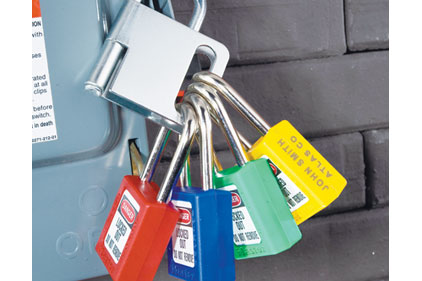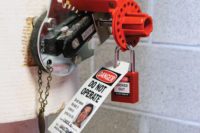Visual communication that accurately and precisely informs your personnel of potentially dangerous conditions should be your goal. This can be accomplished by using signs and tags that are tested to withstand extreme conditions and provide clear, consistent messages to describe situations so workers can do their job and maintain equipment.
OSHA info
OSHA LOTO standards are extensive and for good reason. Many jobs are performed under potentially dangerous conditions, and people are killed or injured every year while working because lockout procedures were not followed. OSHA regulation 1910.147 (Control of Hazardous Energy) provides detailed, specific information related to the use of tags when LOTO maintenance is in progress. Select passages include:
- Tagout devices. “Tagout devices, including their means of attachment, shall be substantial enough to prevent inadvertent or accidental removal. Tagout device attachment means shall be of a non-reuseable type, attached by hand, self locking, and non-releasable with a minimum unlocking strength of no less than 50 pounds and having the general design and basic characteristics of being at least equivalent to a one-piece, all environment-tolerant nylon cable tie.” – 1910.147(c)(5)(ii)(c)(2)
- “Tags must be legible and understandable by all authorized employees, affected employees, and all other employees whose work operations are or may be in the area, in order to be effective.” – 1910.147(c)(7)(ii)(C)
- “Tags and their means of attachment must be made of materials which will withstand the environmental conditions encountered in the workplace.” – 1910.147(c)(7)(ii)(D)
- “Tags must be securely attached to energy isolating devices so that they cannot be inadvertently or accidently detached during use.” – 1910.147(c)(7)(ii)(F)
Color counts
Signs, tags and identification labels should be bright, easy to read and available on demand. Specific colors distinguish specific messages. Red is used for Danger type situations, with a message such as “Do Not Operate” or indicating equipment should not be removed. Orange defines Warning situations such as High Voltage or Restricted Areas, and Yellow expresses Caution should be exercised in areas requiring a Face Shield or Hard Hat. Blue is used in official Notice situations where signage and tags provide information.
Make it personal
A crucial element to OSHA tagout standards is the ability to personalize worker identification tags. You have many choices when it comes to determining how your facility identifies lockout-authorized workers and their equipment. There are options for more permanent types of photo identification labels and tags and engraved locks, or for the simple write-on types.
For example, custom padlock marking can include the option to permanently laser engrave employee names and department information on lightweight thermoplastic and aluminum safety lockout padlocks. You can also find engravable, individual worker ID tags that can easily be attached to the shackles of safety lockout padlocks.
Padlocks with labels allow employees to write their names on the locks. Photo ID padlock labels with the picture of the lockout-authorized employee who performs specific maintenance work is another consideration. The picture of the employee cannot be damaged or tampered with since it is sealed under laminate. Photos also personalize the LOTO situation and help overcome language and literacy barriers.
Industrial environments
Just as important as the message is the method behind the signs and tags you choose to use. With machines and production equipment having many energy sources and operating in a variety of environments, you need assurances sign and tag materials will withstand any and all conditions over a reasonable period of time.
Products available include standard and metal detectable write-on models that have survived a series of rigorous tests and passing QUV environmental testing. These products were able to withstand extreme temperatures and were subjected to testing using a variety of chemicals found in industrial environments. Marker can be easily wiped clean from these signs by using an isopropyl alcohol wipe. If you elect to use the kind where you write an employee’s name or another message, simply wipe it clean for use another time.
Any company can experience and benefit from increased productivity by reducing the risk of employee injury. Smart, sensible and effective communication will help this cause.



